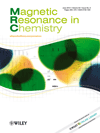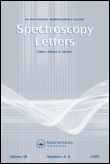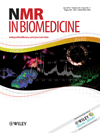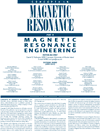
MAGNETIC RESONANCE IN CHEMISTRY
metrics 2024
Pioneering Research in Chemistry and Materials Science
Introduction
MAGNETIC RESONANCE IN CHEMISTRY, published by Wiley, is a prominent journal dedicated to the advancement of knowledge in the field of magnetic resonance as applied to chemistry and materials science. With an ISSN of 0749-1581 and an E-ISSN of 1097-458X, this journal has been an essential resource for researchers since its inception in 1985, maintaining its reputation as a leading publication through its converged years up to 2024. Spanning diverse topics, the journal holds a Q2 quartile ranking in both the Chemistry (miscellaneous) and Materials Science (miscellaneous) categories, illustrating its significance in the academic community. With Scopus rankings placing it in the 61st percentile for General Chemistry and the 55th percentile for General Materials Science, this journal is an esteemed platform for original research, reviews, and critical discussions surrounding magnetic resonance methodologies and applications. As access options are not open, it ensures a curated dissemination of high-quality, peer-reviewed content to support professionals, researchers, and students in their scholarly endeavors.
Metrics 2024
 0.48
0.48 1.90
1.90 1.90
1.90 80
80Metrics History
Rank 2024
Scopus
IF (Web Of Science)
JCI (Web Of Science)
Quartile History
Similar Journals

MAGNETIC RESONANCE IMAGING
Fostering Innovation in Biomedical Engineering and ImagingMAGNETIC RESONANCE IMAGING, published by Elsevier Science Inc, stands at the forefront of research in the fields of Biomedical Engineering, Biophysics, and Radiology, Nuclear Medicine and Imaging. Since its inception in 1982, the journal has become a vital resource, currently enjoying a Q2 ranking in its respective categories as of 2023, underscoring its influence and significance within the scientific community. With an ISSN of 0730-725X and an E-ISSN of 1873-5894, it provides an essential platform for disseminating groundbreaking studies and advancements in magnetic resonance imaging technology and applications. Researchers, professionals, and students benefit from its comprehensive articles that address both theoretical advancements and practical implementation in clinical settings. The journal's commitment to advancing knowledge is reflected in its recognition in Scopus Rankings, where it lies in the 67th percentile for Radiology, Nuclear Medicine and Imaging. By fostering an environment of critical dialogue and innovation, MAGNETIC RESONANCE IMAGING remains a cornerstone publication for those dedicated to pioneering the future of imaging science.

SPECTROSCOPY LETTERS
Advancing Knowledge in Analytical Chemistry and PhysicsSPECTROSCOPY LETTERS, published by Taylor & Francis Inc, is a pivotal journal that plays a significant role in the fields of Analytical Chemistry, Atomic and Molecular Physics, and Optics. With an ISSN of 0038-7010 and E-ISSN of 1532-2289, it provides a platform for the dissemination of cutting-edge research and developments in spectroscopy and its wide-ranging applications. As of 2023, the journal is ranked in the third quartile (Q3) across its relevant categories, reflecting its importance in these scientific domains. The journal has a continuous publication history from 1968 to 2024, establishing a rich legacy in academic literature. Although it currently does not offer Open Access options, SPECTROSCOPY LETTERS remains a valuable resource for researchers, professionals, and students seeking to advance their knowledge and applications in spectroscopy. For those in the arena of physics and chemistry, this journal is essential for keeping abreast of the latest findings and methodologies in the field.

Journal of Structural Biology-X
Elevating Knowledge in the World of Biochemistry and BeyondThe Journal of Structural Biology-X, published by Elsevier, is a leading open-access journal dedicated to advancing the field of structural biology. Launched in 2019, it has quickly established itself as a vital resource for researchers, professionals, and students, boasting a prestigious Q1 ranking in Structural Biology for 2023 and achieving an impressive Scopus rank of #19 out of 49 in the biochemistry, genetics, and molecular biology category. With an E-ISSN of 2590-1524, this journal emphasizes accessibility and collaboration by providing open access to its comprehensive collection of research articles, reviews, and cutting-edge methodologies. The scope of the journal encompasses significant themes within structural biology, including protein structure, molecular interactions, and imaging techniques, facilitating interdisciplinary dialogue and innovation. Join the global community of scientists and contribute to the body of knowledge that propels our understanding of molecular architecture through the Journal of Structural Biology-X.

JOURNAL OF FLUORESCENCE
Advancing the Frontiers of Fluorescence ScienceJournal of Fluorescence, published by Springer/Plenum Publishers, is a pivotal interdisciplinary journal focusing on the application and innovation of fluorescence methodology across various scientific domains. With an ISSN of 1053-0509 and an E-ISSN of 1573-4994, this journal facilitates the dissemination of significant research findings from 1991 to 2024. The journal has established itself as a key resource in fields such as Biochemistry, Clinical Biochemistry, and Spectroscopy, demonstrating its importance by maintaining a Q3 ranking in multiple categories in 2023, including Biochemistry and Clinical Biochemistry. While currently not offering open access, the journal's commitment to scholarly rigor is reflected in its Scopus rankings and diverse readership, making it an essential source of knowledge for researchers, professionals, and students engaged in the rapidly evolving landscape of fluorescence research.

Journal of Magnetic Resonance Open
Connecting Minds through Groundbreaking Magnetic Resonance StudiesThe Journal of Magnetic Resonance Open, published by ELSEVIER, is a premier open access journal dedicated to the dissemination of groundbreaking research in magnetic resonance and its applications across various scientific domains. Since its launch in 2019, this journal has carved a niche in the fields of analytical chemistry, electronic, optical, and magnetic materials, as well as radiology and spectroscopy. It holds a commendable position in the academic community, reflected by its 2023 category quartiles, ranking Q2 in both analytical chemistry and electronic materials, and Q3 in radiology and spectroscopy. With an emphasis on open access, Journal of Magnetic Resonance Open provides unrestricted access to research articles, fostering collaboration and innovation. Researchers, professionals, and students will find valuable insights within its pages, contributing to the growing body of knowledge in these dynamic fields, making it an essential resource for staying at the forefront of scientific advancements.

MAGNETIC RESONANCE MATERIALS IN PHYSICS BIOLOGY AND MEDICINE
Elevating Research in Magnetic Resonance TechnologiesMAGNETIC RESONANCE MATERIALS IN PHYSICS BIOLOGY AND MEDICINE, published by SPRINGER, is a premier academic journal dedicated to advancing the fields of biophysics, radiology, and medical imaging. With a strong presence in Germany and an international readership, this journal has established itself as a vital resource for researchers and professionals engaged in the interdisciplinary study of magnetic resonance applications. Featuring a commendable 2023 impact factor and categorized in Q2 quartiles across several domains—including Biophysics and Radiological Technologies—this journal provides a platform for innovative research and practical implementations in the field. Although it does not follow an Open Access model, it offers extensive archives dating back to 1984, affirming its long-standing commitment to scholarly excellence. The journal not only ranks impressively within Scopus metrics, but it also promotes ongoing discourse that bridges gaps between physics, biology, and medicine, making it an essential read for professionals and students aiming to stay informed about cutting-edge developments.

NMR IN BIOMEDICINE
Advancing the Frontiers of NMR in Biomedical ResearchNMR in Biomedicine is a prestigious journal published by Wiley that has been at the forefront of advancing research in the integration of Nuclear Magnetic Resonance (NMR) techniques within the realms of biomedicine since its establishment in 1988. With its ISSN 0952-3480 and E-ISSN 1099-1492, this journal focuses on the application of NMR across various scientific disciplines, including Molecular Medicine, Radiology, Nuclear Medicine and Imaging, and Spectroscopy. The journal is classified in the Q1 and Q2 quartiles as of 2023, showcasing its significant impact and contribution, particularly in Radiology and Spectroscopy, where it ranks in the top tier of its fields. The Scopus ranks reflect its esteemed position, with notable placements such as #70/333 in Radiology and #25/76 in Chemistry Spectroscopy. While Open Access options are not available, the journal remains committed to providing high-quality, peer-reviewed research that fosters innovation and collaboration within the scientific community. Researchers, professionals, and students are encouraged to explore the cutting-edge findings presented in this journal, as it continues to shape the future of biomedical applications of NMR.

Journal of the Korean Magnetics Society
Advancing the frontiers of magnetics research.Journal of the Korean Magnetics Society, published by the Korean Magnetics Society, is a prestigious academic journal dedicated to advancing the field of magnetics. Renowned for its contributions to both fundamental and applied magnetics research, this journal spans a wide range of topics, including magnetic materials, magnetometry, and applications in technology. Aimed at researchers, professionals, and students, it serves as a vital platform for disseminating high-quality research and innovative findings within the magnetics community. Although it does not currently offer Open Access options, the journal maintains a high academic standard, supported by its commitment to rigorous peer review processes. Its ISSN 1598-5385 and E-ISSN 2233-6648 ensure that it is easily traceable within academic databases, promoting continuous engagement and scholarship in the disciplines of physics and engineering related to magnetic phenomena. Whether you are looking to publish cutting-edge research or stay abreast of the latest discoveries in magnetics, the Journal of the Korean Magnetics Society is an indispensable resource.

CONCEPTS IN MAGNETIC RESONANCE PART B-MAGNETIC RESONANCE ENGINEERING
Advancing Magnetic Resonance Engineering for a Healthier Tomorrow.CONCEPTS IN MAGNETIC RESONANCE PART B-MAGNETIC RESONANCE ENGINEERING is a premier journal published by WILEY-HINDAWI, dedicated to advancing the field of magnetic resonance engineering. With an ISSN of 1552-5031 and E-ISSN 1552-504X, this journal offers an Open Access platform since 2022, ensuring that research is freely accessible to scholars worldwide. Covering a broad spectrum of applications in medicine, radiology, nuclear medicine, and imaging, it serves as a key resource for professionals looking to stay updated with the latest advancements and innovations in the field. The journal enjoys notable rankings in various categories, including a rank of #137 in Medicine and #26 in Health Professions within Scopus, reflecting its importance and influence in both academic and clinical settings. As a vital conduit for cutting-edge research, CONCEPTS IN MAGNETIC RESONANCE PART B is committed to fostering the growth of knowledge while addressing the critical challenges and technological enhancements within magnetic resonance methodologies. Researchers, professionals, and students can expect to find comprehensive articles that adhere to high scientific standards, promoting discourse and collaboration across disciplines.

Journal of Spectroscopy
Innovative Insights in Atomic and Molecular PhysicsJournal of Spectroscopy, published by HINDAWI LTD since 2009, is a renowned Open Access journal based in Egypt that serves as a valuable platform for the dissemination of cutting-edge research in the fields of analytical chemistry, atomic and molecular physics, and optics. With the unique ISSN 2314-4920 and E-ISSN 2314-4939, this journal aims to facilitate collaboration and knowledge exchange among researchers, professionals, and students by providing unrestricted access to essential findings and advancements. As of 2023, it holds a Q3 ranking in both Analytical Chemistry and Atomic and Molecular Physics, and a Q4 ranking in Spectroscopy, indicating its growing influence and relevance within the academic community. The journal also maintains a Scopus rank of #126 in Atomic and Molecular Physics and #53 in Spectroscopy, showcasing its commitment to high-quality scholarly content. With a converged timeline from 2013 to 2024, the Journal of Spectroscopy is positioned as a pivotal resource for the latest discoveries and innovative applications in spectroscopy-related studies.